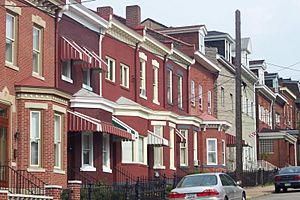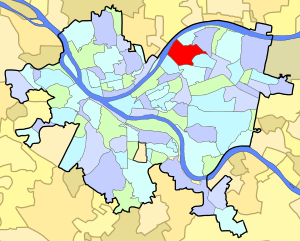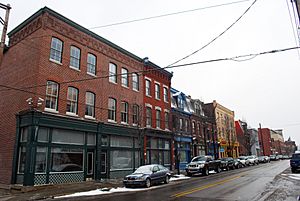Lawrenceville (Pittsburgh) facts for kids
|
||||||||||||||||||||||||||||||||||||||||||||||||||||||||||||||||||||||||||||||||||||||||||||||||
Lawrenceville is a large neighborhood in Pittsburgh, Pennsylvania, in the United States. It is located northeast of downtown Pittsburgh. Like many areas along the river, it used to be a big industrial center. Even though the city divides Lawrenceville into three parts—Upper Lawrenceville, Central Lawrenceville, and Lower Lawrenceville—most people think of it as one big neighborhood.
In 2019, the Lawrenceville Historic District was added to the National Register of Historic Places. This means many buildings in the area are protected because of their historical importance.
History of Lawrenceville
Lawrenceville was started in 1814 by William B. Foster. He was the father of the famous composer Stephen Foster, who was born in Lawrenceville in 1826. The neighborhood is named after Captain James Lawrence, a hero from the War of 1812. He is famous for his last words: "Don't Give Up The Ship!"
Lawrenceville was chosen for the Allegheny Arsenal, a place where weapons were made. This was because it was easy to reach by river and close to where iron was produced. Lawrenceville became a borough (a small town with its own government) in 1834. Later, in 1868, it became part of the city of Pittsburgh.
Long ago, there were two large islands in the Allegheny River across from Lawrenceville. One was Herrs Island, now called Washington's Landing. The other was McCullough's Island. Washington's Landing is named after George Washington. In 1753, he fell out of his raft while crossing the river and found safety on a nearby island. He actually landed on McCullough's Island, not the one named after him! McCullough's Island is gone now, perhaps it eroded away or became part of the mainland.
Lawrenceville Today
Lawrenceville is a lively neighborhood with a mix of old and new. It still has many narrow row houses and old warehouses, showing its industrial past. You can find important places here like Allegheny Cemetery, Arsenal Middle School, Arsenal Park, and Doughboy Square.
A big change happened in 2009 when the UPMC Children's Hospital of Pittsburgh opened a new facility in Lawrenceville. This brought new jobs and businesses to the area. The New York Times has even called Lawrenceville a "go-to destination." Many young people are moving here because the housing is still somewhat affordable.
Lawrenceville is now a popular spot for art, live music, and dining in Western Pennsylvania. Butler Street is the main street, filled with restaurants, shops, and coffee shops. Some popular places include Industry Public House and Piccolo Forno. You can also find Church Brew Works, a brewery made from an old church. For fun, there's Arsenal Lanes, a bowling alley, and Row House Cinema, a movie theater that shows classic films.
The nightlife in Lawrenceville has grown a lot. People from nearby areas come to enjoy the music and venues. For example, the old Moose Lodge became Spirit Lodge, a place with two dance floors and a pizza parlor.
Lawrenceville also hosts Pittsburgh's yearly Art All Night event. This is where amateur artists can show their work for free in a large warehouse.
In recent years, Lawrenceville has seen a lot of growth in real estate. Many homes are being bought and renovated. This has made house prices go up. While this brings new energy, it also means that parking can be hard to find on the streets.
Despite all the changes, Lawrenceville keeps its old traditions alive. There's an annual Memorial Day parade on Butler Street. Residents also celebrate "Doo Dah Days," a festival honoring Stephen Foster's music. Arsenal Park is still a favorite spot for recreation, hosting July 4 events. The VFW center and Teamster Temple are also active parts of the community.
Nearby Neighborhoods
Lawrenceville is surrounded by several other Pittsburgh neighborhoods.
- Lower Lawrenceville borders Central Lawrenceville to the northeast, Bloomfield to the east, Polish Hill to the south, and the Strip District to the southwest. Across the Allegheny River, it's near Troy Hill and Millvale, with a bridge connecting to Millvale.
- Central Lawrenceville borders Upper Lawrenceville to the north, Stanton Heights to the east, Garfield to the southeast, Bloomfield to the south, and Lower Lawrenceville to the southwest. Across the river, it's near Millvale and Shaler Township.
- Upper Lawrenceville borders Morningside to the east, Stanton Heights to the southeast, and Central Lawrenceville to the south. Across the Allegheny River, it's near Shaler Township.






